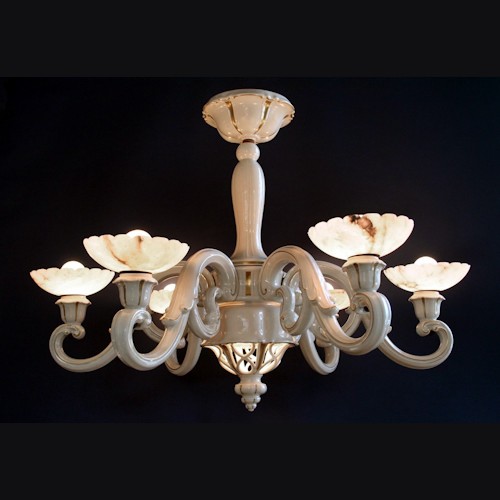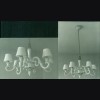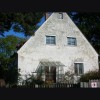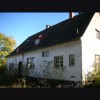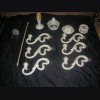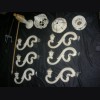Kronleuchter #80- Allach/ Rosenthal
Please contact us directly if you would like to purchase this item.
Price: Upon Request
This piece is beautiful and came over to the United States with German couple who migrated here in 1948. The second photo shows the piece hanging in Dusseldorf where it was originally installed before it was taken down and bought over to the states with them. You can understand why someone would go to all the trouble to bring such an item in their travels when you see something like this and its gorgeous. When I purchased this from the family they wanted to see it hung and it was my intention to hang it but today it remains on the floor neatly in about 13 pieces. I shutter to think what such an item would cost today...
The history of Allach is well known, most of it anyway if you follow it closely enough. Franz Nagy was the designer for this piece and the man who originally owned the property for the initial PMA house in Munich ( 3-4 ). Nagy joined with Heinrich Himmler "Reichsfuhrer SS", Karl Diebitsch a Standartenfuhrer in the SS, and Theodore Karner later Professor Karner to manufacture what we know today to be PMA or Allach porcelain. The venture as we know would last from about 1936-1945 and with the end of the war comes the end of Allach porcelain, but the history does not end there. For the duration of 9 years Allach manufactured approx. 200 different models in addition to medals etc. Production figures are scattered with the most often quoted being common published figures from 1938-39. The problem with the production figures is that the firm is running production in batches and where you see an item with so many manufactured, that may be just be one batch, or that might be it. In the case of the #80, it is one of the rare instances where the firm appears to strike the model and then replaces it with another model utilizing the same #. Needless to say, the Kronleuchter appears to disappear in 1937 and was replaced by the #80 Roebuck. So you lose the figures but you can bet they did not manufacture many and I believe there are 2 known.
In the case of Franz Nagy things get interesting in that his models fall off after 1937 and many just cease to exist with many being some of rarest to be found and commanding substantial premiums. The bulk of the newer models are picked up by Theodore Karner and Karl Diebitsch, and Nagy just about disappears and most probably fell out of favor, I am sure there is a reason for this and I have never researched it but he survived and lived until 1959. The artists of Allach all survive and the most successful is Karner who go's on to work for multiple firms and produce a large number of models. In the end the firm is closed shuttered and becomes the property of the state.
Artists being artists and their models being their own property, we see the same models produced before the war, after the war, during the war, all bearing their name. When Allach meets its demise and once the war has settled the PMA locations retain all the molds by the artists who worked for the firm including those of Karner, Diebitsch, and Nagy. These molds are sought after by the artists and many of which now work for other firms and requests are made to the state for these molds. There is evidence of this somewhere and I will have to see if I can find it and I believe this occurs in 1947 and there is a document. By 1948 these molds are out in the hands of other manufactures and you see some of these models being manufactured by other firms including Rosenthal, Nymphenburg, and in one case a rearing stallion still has a raised octagon and the maker mark of Nymphenburg leaving no question of it being an Allach mold.
In 1948 the firm of Rosenthal manufactures a Kronleuchter by Nagy. This is not a typical model by any means and while Allach made two variants of the leuchter, this one is no doubt off Allach molds. And not unlike its time at Allach where they were few made, the Rosenthal example likely saw limited manufacture as well as it had to be cost prohibitive and would cost a fortune today. When I initially saw the photos of this and spent some time I swore they were wrong about manufacture as it is absolutely identical to the pre-war example with gold accent (Photo 1)
This is offered as mint and undamaged, its came in a lot of boxes and a lot of care was taken to get it here, its beautiful. I do not have the bobeche pieces but they can be had. Photos 2 from Dusseldorf shows they had shades on it. I did buy shades and bulbs and still have them here. This is certainly not for everyone and I purchased this for myself and for what it is and it is fairly exotic. Photos 5-6
Shipping on this will need to be discussed...
- $3,495.00
- Availability: In Stock
This piece is beautiful and came over to the United States with German couple who migrated here in 1948. The second photo shows the piece hanging in Dusseldorf where it was originally installed before it was taken down and bought over to the states with them. You can understand why someone would go to all the trouble to bring such an item in their travels when you see something like this and its gorgeous. When I purchased this from the family they wanted to see it hung and it was my intention to hang it but today it remains on the floor neatly in about 13 pieces. I shutter to think what such an item would cost today...
The history of Allach is well known, most of it anyway if you follow it closely enough. Franz Nagy was the designer for this piece and the man who originally owned the property for the initial PMA house in Munich ( 3-4 ). Nagy joined with Heinrich Himmler "Reichsfuhrer SS", Karl Diebitsch a Standartenfuhrer in the SS, and Theodore Karner later Professor Karner to manufacture what we know today to be PMA or Allach porcelain. The venture as we know would last from about 1936-1945 and with the end of the war comes the end of Allach porcelain, but the history does not end there. For the duration of 9 years Allach manufactured approx. 200 different models in addition to medals etc. Production figures are scattered with the most often quoted being common published figures from 1938-39. The problem with the production figures is that the firm is running production in batches and where you see an item with so many manufactured, that may be just be one batch, or that might be it. In the case of the #80, it is one of the rare instances where the firm appears to strike the model and then replaces it with another model utilizing the same #. Needless to say, the Kronleuchter appears to disappear in 1937 and was replaced by the #80 Roebuck. So you lose the figures but you can bet they did not manufacture many and I believe there are 2 known.
In the case of Franz Nagy things get interesting in that his models fall off after 1937 and many just cease to exist with many being some of rarest to be found and commanding substantial premiums. The bulk of the newer models are picked up by Theodore Karner and Karl Diebitsch, and Nagy just about disappears and most probably fell out of favor, I am sure there is a reason for this and I have never researched it but he survived and lived until 1959. The artists of Allach all survive and the most successful is Karner who go's on to work for multiple firms and produce a large number of models. In the end the firm is closed shuttered and becomes the property of the state.
Artists being artists and their models being their own property, we see the same models produced before the war, after the war, during the war, all bearing their name. When Allach meets its demise and once the war has settled the PMA locations retain all the molds by the artists who worked for the firm including those of Karner, Diebitsch, and Nagy. These molds are sought after by the artists and many of which now work for other firms and requests are made to the state for these molds. There is evidence of this somewhere and I will have to see if I can find it and I believe this occurs in 1947 and there is a document. By 1948 these molds are out in the hands of other manufactures and you see some of these models being manufactured by other firms including Rosenthal, Nymphenburg, and in one case a rearing stallion still has a raised octagon and the maker mark of Nymphenburg leaving no question of it being an Allach mold.
In 1948 the firm of Rosenthal manufactures a Kronleuchter by Nagy. This is not a typical model by any means and while Allach made two variants of the leuchter, this one is no doubt off Allach molds. And not unlike its time at Allach where they were few made, the Rosenthal example likely saw limited manufacture as well as it had to be cost prohibitive and would cost a fortune today. When I initially saw the photos of this and spent some time I swore they were wrong about manufacture as it is absolutely identical to the pre-war example with gold accent (Photo 1)
This is offered as mint and undamaged, its came in a lot of boxes and a lot of care was taken to get it here, its beautiful. I do not have the bobeche pieces but they can be had. Photos 2 from Dusseldorf shows they had shades on it. I did buy shades and bulbs and still have them here. This is certainly not for everyone and I purchased this for myself and for what it is and it is fairly exotic. Photos 5-6


